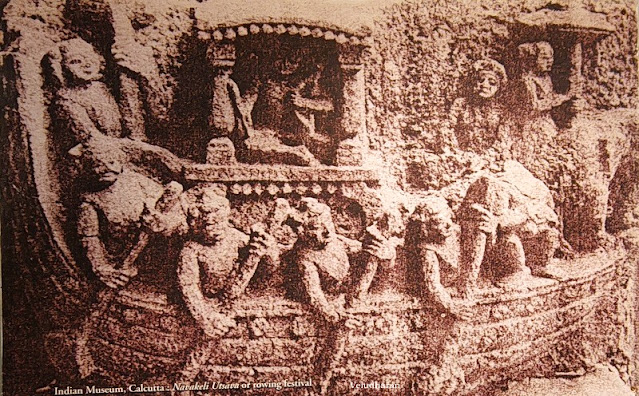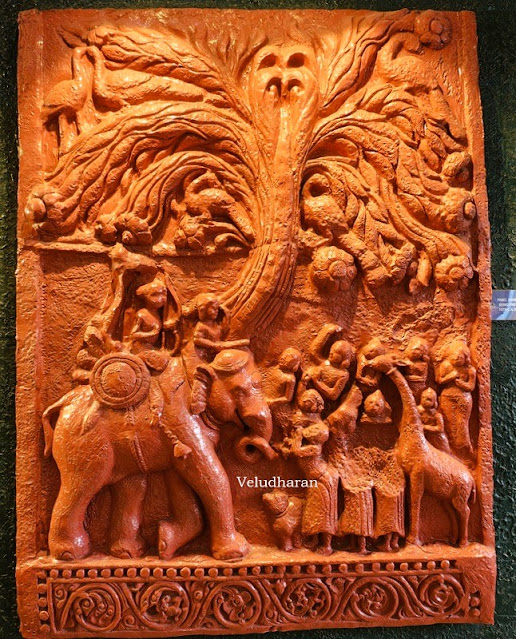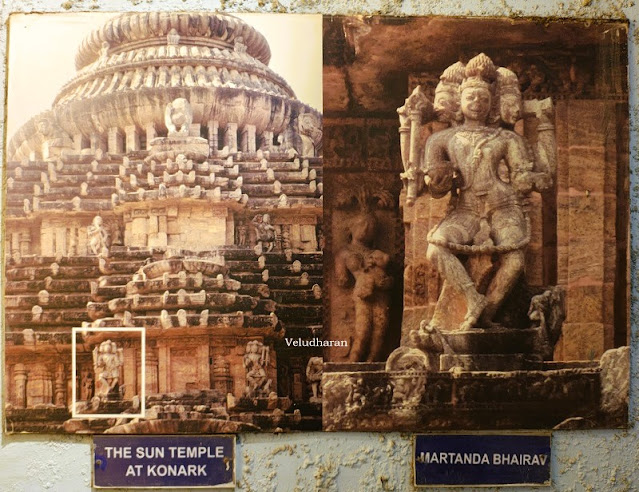The visit to this Bharabati
Maritime Museum at Cuttack, Odisha was a part of the “Kalinga and Ottara Desa
Heritage Walk” organised by சோழ மண்டல வரலாற்றுத் தேடல் குழு, between 13th to 18th September 2024. The purpose of this Heritage walk was to see the places,
monuments, etc., which are directly or indirectly connected as proof of
Rajendra Chozha’s victory mentioned in his meikeerthi/title over Kalinga and
Ottara Desa, the present Andhra Pradesh and Odisha.
The Odisha State Maritime
Museum at Jobra, Cuttack was inaugurated by Shri Naveen Patnaik, the Honourable
Chief Minister of Odisha in the presence of
Shri Bhartruhari Mahatab, Honourable M P Cuttack on 1st April 2013.
ODISHA STATE MARITIME MUSEUM,
CUTTACK
It has 14 numbers of galleries
along with its ancillary components, as required in a modern museum. This
location, which has a beginning around 1869 CE, has the unique distinction of being
the only workshop, that catered to the requirements of three provinces of
Bihar, Bengal, and Odisha under the Bengal Presidency of British India. It was
set up by the then PWD department of British administration through the efforts
of one Scottish Engineer Mr.G.H. Faulkner immediately after the great famine of
1866 CE, in Odisha, known as "Naa Anka Durviksha". The British
administration took up the work of excavating the Coast Canal, Taladanda Canal, and other irrigation projects to counter the effects of drought. This workshop mainly caters to the needs for anicuts, dams, canals, and most importantly
inland water transport systems. At that time the access to Calcutta from Cuttack
was only through a journey on river Mahanadi to the False Point near Paradeep
and on sea up to Calcutta or from Chandabali to Calcutta
MARITIME HISTORY
Crossing the high seas braving
the hazards of the sea, travel has been part of human traits since time
immemorial. Trans-oceanic voyages were meant to search for new land to live,
trade, and colonize as seen from the pages of the history of mankind.
Indian sub-continent with its
vast coastline offered the early voyagers a challenge to cross the high seas
and travel to different countries in South, and South East Asia as well as to the
Arabian coast. Similarly seafaring people from early Civilizations like Rome,
Greece, Babylon, etc., and later sailors from England and European countries and
Arab countries from the west and China, Cambodia, Indonesia, Srilanka, etc.
from the East and South touched several ports of ancient and medieval India.
From among the ancient Indian people the Kalingas, the Cholas, the Palas, and
the Cheras were known to have set sail across the ocean for distant lands.
This Gallery depicts the
maritime history of India as well as Odisha with appropriate illustrations,
maps, charts, and objects.
MARITIME HISTORY OF INDIA
A large number of ports,
forts, and trading centers along the coastline of the country bear testimony to
the maritime history of India. The archaeological evidence found in Indian
excavated sites and other such sites in outside countries indicates the cultural
interaction between India and other countries in ancient and medieval periods
of Indian history.
In the Indian context, voyages on the sea are referred to in the Vedic Literature. Before the Vedic age, the Harappan
Culture had developed and mastered the art of sea voyage as evidenced by the
excavation at Lothal in Gujarat where an ancient dockyard has been exposed
MARITIME HISTORY OF ODISHA
Although Kalinga or ancient
Odisha played an important role in maritime activities from very early
times its maritime history is not very well documented or exposed and has not
received due attention. The maritime tradition and rituals are very popular
throughout the state of Odisha. From archaeological evidence and literary
sources, it is evident that ancient Odisha, known as Kalinga, was a great
maritime power from about the 7th B.C to the 13th Century CE. It had
overseas trade relations with ancient countries like Greece, Rome, Java, Sumatra,
Brahmadesa, Simhala, Bali, Malay, etc.
The ancient Kalinga coast had
famous ports like Tamralipti, Palur, Baruva, Che-Li-ta-Lo, etc. which were
referred to by Geographers and Travellers like Ptolemy, Pliny, Fahien, Hieun
Tsang or Ywan Chwang and others.
The findings of Roman pottery,
rouletted ware, coins, and terracotta objects from excavated sites of
Sisupalgarh indicate the trade relation with the ancient Roman empire. Similarly, the discovery of knobbed ware from sites of Odisha such as Radhanagar, Sisupalagarh,
Kuruma, Manikapatna, Brahmavana, Khalkatapatna, etc, and their discovery in sites
of Bali, Java, Kalimantan in Indonesia and Malaysia prove the ancient overseas
connection between these regions. The findings of Chinese porcelain, ceramic,
Arabic stoneware, and Ceylonese coins from Odishan sites prove ancient maritime
relations of ancient Odisha with China, Srilanka and Arab countries
STEPS OF CONSTRUCTION OF A
BOAT IN ODISHA
1. The required type of wood is
selected and properly seasoned
2. Wooden planks of good quality
are arranged.
3. Planks are cut to size and
shaped by finishing work,
4. Bending of the wooden plank is
done by heating and putting pressure up to a fixed time.
5. Planks are joined to the required
shape gradually with inner support for creating breadth, side inclination, etc.
6. The joints are fixed by iron
nails. The joints are also made water-tightened. The boat is completed as per the required shape and size.
7. It is shifted to water front
for floating.
8. Rituals are performed before
sailing of the Boat.
While boats played on rivers,
lakes, and other large water bodies, Ships were the means to sail across high
seas. Literary references, as well as depictions of boats and ships in sculpture, painting, coins, terracotta figurines, and clay seals, give us an idea about the
types of vessels used earlier by people of the Indian subcontinent. In the Indian
context, voyages on the sea are referred to in the Vedic literature. Before the Vedic
age, the Harappan culture had developed and mastered the art of sea voyage as
evidenced by the excavation at Lothal in Gujarat where a dockyard was
exposed
It seems the ancient Odia
traders were overshadowed by the Arab traders in maritime trade after the 13th-14th
century and the overseas trading of Odia merchants almost came to an end. This
is apparent from the allusions of the proverb "Aa ka ma bai -Pana gua
thoi" found in the Mahabharata of Sarala Dasa, written in the 15th century
A.D.
The maritime relations of
Kalinga had left its strongest impact in countries like Sri Lanka, Myanmar,
Indonesia, Malaysia, and Thailand. The Hindu culture of the Island State of Bali
in Indonesia has great similarities with Odia culture. The life and culture of
Balinese and Odia people have strange coincidences in the sphere of language,
dialect, religious practices, performing arts, crafts, and architecture along
with the cluster of place names.
BALI YATRA.
Baliyatra Festival in Cuttack is an auspicious festival celebrated on “Kartika
Purnima” Every Year. The seven days long festival held in November is observed
as the largest trade Fair in Odisha. This fair is extremely popular and the
festival is celebrated with much pomp and grandeur in the historic city of
Cuttack on the bank of river Mahanadi from the day of “Kartika Purnima”. Lakhs
of people throng to enjoy the fair.
The literal meaning of Baliyatra is “Voyage to Bali”. It is a unique
socio-cultural event with a history of a thousand years old which commemorates the
past association of the people of Odisha with Bali and other South-East Asian
Countries. The celebration of Baliyatra takes us back to remember our cultural
heritage and maritime legacy.
Through the celebration, Odisha boasts the strength of its culture,
art, temples, and monuments, distinctive style of architecture, elegant textile
designs, special cuisine, and so on. This amalgamation of art and culture
refreshes the memory of Kalinga’s glory as well as promotes Tourism.
INDONESIA
GALLERY
In 2018, a ten-member delegation from Indonesia led by Mr. Agus Indra Udyan, a Padmashree
recipient visited Odisha and participated in Baliyatra as a special guest to
make it a true symbolic representation of Baliyatra (Voyage to Bali,
Indonesia). The delegation was overwhelmed to see the culture, love, and
affection of the people of Odisha during their short stay of Odisha and performed
throughout "Bali yatra" with their traditional Balinese dance and yoga
performance.
The Odisha State
Maritime Museum (OSMM) located on the right bank of river Mahanadi, Jobra,
Cuttack is recognized as one of the only museums in India dedicated to Maritime
history. The delegation went around the Museum and was extremely overjoyed to
see the ambiance of the museum and the existing gallery dedicated to Odisha-Indonesia maritime and cultural linkages and similarities. The message of this
unique museum was conveyed to the Indonesian government and eminent people of
Bali and they took it most positively and desired their association.
They desired a dedicated "Indonesia Gallery" in the Odisha State
Maritime Museum. Several gifts were received from the Embassy of Indonesia
in India and the former Governor of Ball for the awareness of visitors in both
Odisha and Indonesia. The gifts include the rare "GAMELAN" musical
Instruments comprising 25 different Instruments played by 25 artists from the Indonesian Embassy, the beautiful "Padmasana" Temple made of Volcano
soil, the rare paintings, sculptures, masks, and many other items.
Now it is going
to be a history in Odisha - Indonesia relationship by dedicating this unique
"Indonesia Gallery" to the public by our Hon'ble Chief Minister,
Odisha.
Making of Museum
This location, which has a
beginning around 1868 has the unique distinction of being the only workshop,
that catered to the requirements of three provinces of Bihar, Bengal, and Orissa
under the Bengal Presidency of British India. It was set up by the then PWD
department of British administration through the efforts of one Scottish
Engineer Mr. G. H. Faulkner immediately after the great famine of 1866 in
Orissa.
INTACH Odisha has restored and
developed the Odisha State Maritime Museum, which has been set up at this Jobra
Workshop and has various galleries along with its ancillary components showcasing
the Maritime History of Odisha.
The Project was funded and
supported by the Department of Water Resources, Government of Odisha. We are thankful
to the Hon'ble Chief Minister of Odisha for his interest in the revival of this
historic project.
LOCATION OF THE MUSEUM: CLICK HERE

































No comments:
Post a Comment